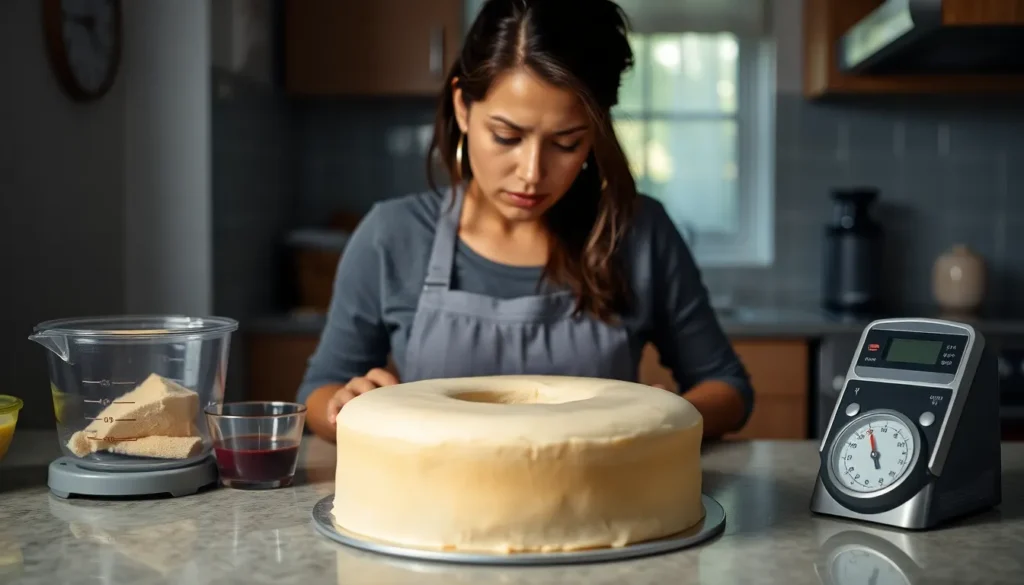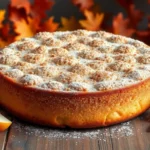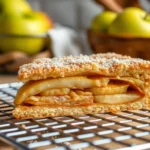We’ve all been there – you open the oven door with excitement only to find your beautiful cake has collapsed into a sad sunken mess. That heart-sinking moment when your perfectly risen cake decides to deflate faster than a popped balloon is every baker’s nightmare.
Sunken cakes aren’t a baking mystery that can’t be solved. There are exact scientific reasons why cakes fall and once you understand these culprits you’ll never have to deal with this frustrating problem again. From oven temperature mishaps to ingredient measurement errors the causes are more common than you’d think.
The good news? We’re about to reveal the exact reasons your cake sank and give you foolproof answers to ensure your next bake rises beautifully and stays that way. Let’s jump into the science behind cake collapse and transform you from a frustrated baker into a confident cake master who knows exactly what went wrong and how to fix it.
Why Did My Cake Sink: Common Causes and Solutions
Understanding the science behind cake failures helps us identify exact problems and carry out targeted answers. We’ve compiled the most frequent causes of sunken cakes along with proven methods to prevent each issue.
Incorrect Oven Temperature
Oven temperature discrepancies rank as the primary culprit behind collapsed cakes. Most home ovens display inaccurate temperatures that can vary by 25-50 degrees from the actual setting. When temperatures run too low the cake bakes slowly and fails to set its structure before the leavening agents lose their power. Excessive heat causes rapid rising followed by dramatic collapse as the cake’s structure cannot support itself.
We recommend investing in an oven thermometer to verify actual temperatures. Preheat your oven for at least 15 minutes before baking and avoid opening the door during the first two-thirds of baking time. Position racks in the center of the oven for even heat distribution.
Opening the Oven Door Too Early
Premature oven door opening creates temperature fluctuations and vibrations that destroy delicate cake structures. The sudden rush of cool air causes partially set batters to collapse instantly. Most cakes need at least 75% of their baking time to develop sufficient structure before they can withstand environmental changes.
Resist the urge to check your cake’s progress until the minimum baking time has elapsed. Use the oven light instead of opening the door when you need to monitor browning. Trust the recipe timing and perform the toothpick test only after the specified baking period.
Measurement Errors
Precise ingredient ratios maintain the chemical balance necessary for proper cake structure. Too much liquid creates heavy batter that cannot support itself during baking. Excessive leavening agents cause rapid overrising followed by collapse. Insufficient flour fails to provide adequate structure for the cake to maintain its height.
Measure ingredients using proper techniques for accurate results. We use the spoon and level method for flour rather than scooping directly from the container. Liquid ingredients require clear measuring cups placed on level surfaces. Digital scales provide the most precise measurements for consistent baking results.
Overmixing the Batter
Excessive mixing develops gluten strands that create tough dense textures instead of light airy structures. Overmixed batters trap less air and produce cakes that sink as they cool. The mixing process should incorporate ingredients just until combined with no visible flour streaks remaining.
Stop mixing immediately when ingredients come together. Use gentle folding motions for delicate batters and avoid electric mixers once flour is added. Lumpy batter often bakes better than perfectly smooth overmixed batter.
Altitude and Humidity Effects
High altitude locations experience lower air pressure that causes excessive rising and subsequent collapse. Humidity affects ingredient behavior and baking times significantly. Dry climates may require additional moisture while humid conditions can make batters too wet.
| Altitude Range | Adjustment Needed |
|---|---|
| 3,000-5,000 feet | Reduce leavening by 1/8, increase liquid by 2-4 tablespoons |
| 5,000-6,500 feet | Reduce leavening by 1/8-1/4, increase liquid by 3-4 tablespoons |
| Above 6,500 feet | Reduce leavening by 1/4, increase liquid by 3-4 tablespoons, increase oven temperature by 15-25°F |
Monitor local humidity levels and adjust recipes accordingly. Store ingredients in airtight containers to prevent moisture absorption that can alter their properties.
Understanding the Science Behind Cake Structure
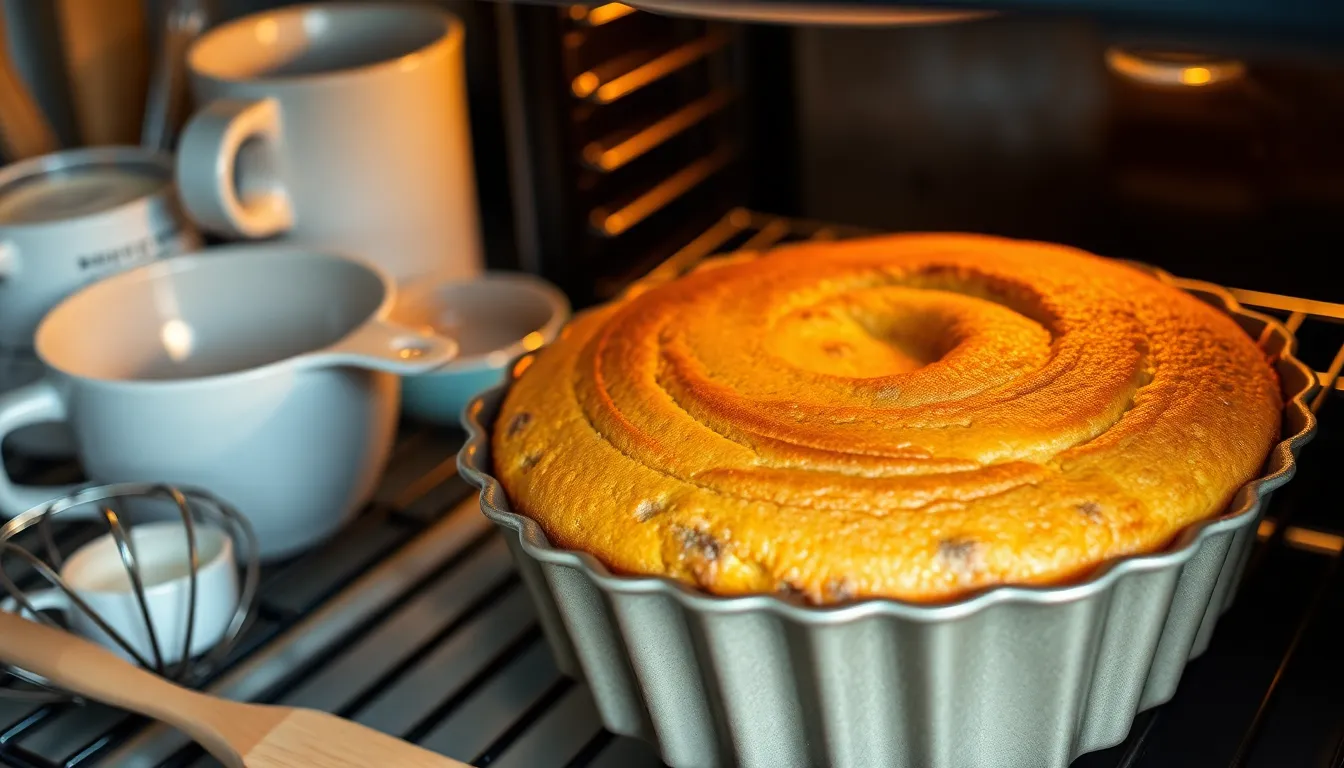
When we examine why cakes sink we need to understand the complex interactions between ingredients that create a cake’s structure. Successful cake baking relies on achieving the perfect balance between flour proteins eggs and leavening agents to create a stable framework that maintains its shape.
The Role of Leavening Agents
Leavening agents serve as the powerhouse behind every successful cake rise. We rely on baking powder and baking soda to create the gas bubbles that lift our batter and give cakes their light fluffy texture. But the amount we use makes all the difference between success and disaster.
Using too much leavening agent creates an overly aggressive rise that cannot sustain itself. Our cakes shoot up rapidly in the oven then collapse as the structure becomes too weak to support the excessive lift. The general rule we follow is one teaspoon of baking powder per cup of flour to maintain proper balance.
Expired leavening agents present another common problem that leads to sunken cakes. We must check expiration dates regularly because inactive leavening agents fail to provide the necessary lift. Fresh baking powder and baking soda ensure our cakes rise properly and maintain their structure throughout the cooling process.
How Temperature Affects Rising
Oven temperature plays a critical role in setting the cake’s structure at the right pace. When we bake at incorrect temperatures we disrupt the delicate process of protein coagulation and starch gelatinization that gives cakes their stability.
Ovens that run too hot cause rapid surface browning while leaving the interior underbaked. This creates a weak internal structure that cannot support the cake’s weight as it cools. Conversely ovens running too cold result in insufficient heat to properly set the proteins and starches.
Opening the oven door frequently during baking introduces sudden temperature fluctuations that weaken the developing structure. We recommend avoiding door openings during the first three quarters of baking time to prevent these destabilizing temperature changes.
The Importance of Proper Mixing
Mixing technique directly impacts the amount of air incorporated into our batter and affects the final cake structure. Overmixing introduces excessive air bubbles that create an unstable foam structure prone to collapse.
When we overmix cake batter we develop too much gluten in the flour which creates a tough dense texture. This overdeveloped gluten network cannot support the leavening action properly leading to structural failure and sinking.
Over creaming butter and sugar also contributes to cake sinking by incorporating too much air into the mixture. We achieve optimal results by creaming just until the mixture becomes light and fluffy without continuing to the point of separation or excessive aeration.
Most Common Reasons Your Cake Sank
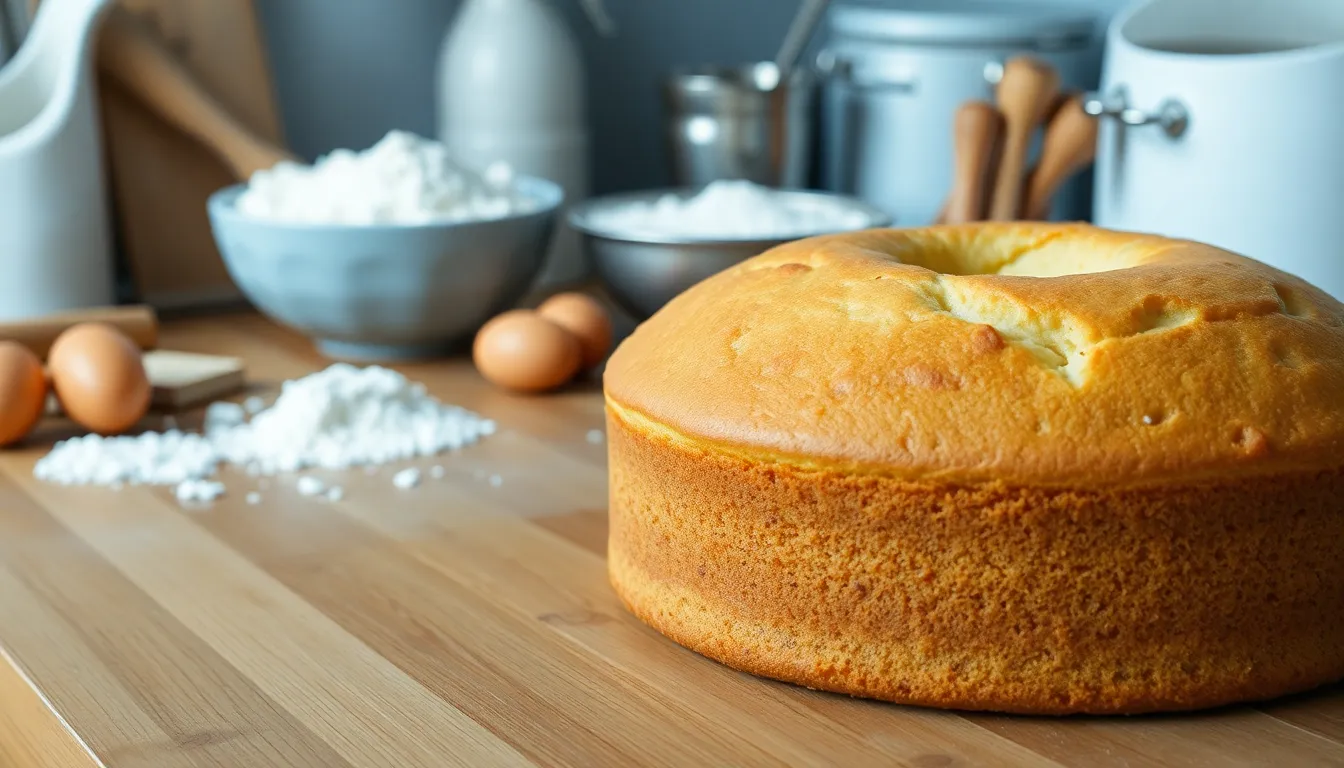
Understanding these primary causes will help you identify exactly what went wrong and prevent future baking disasters. We’ve identified the most frequent culprits that lead to sunken cakes based on expert analysis and food science research.
Opening the Oven Door Too Early
Disrupting the baking process by opening the oven door prematurely wreaks havoc on your cake’s delicate structure. Heat and air escape rapidly when you peek too early causing the internal framework to collapse before it has properly set. We recommend waiting until at least 75% of the baking time has elapsed before checking your cake. Temperature fluctuations during this critical period prevent the proteins and starches from forming the stable network your cake needs to maintain its height.
Incorrect Oven Temperature
Oven temperature inaccuracies rank among the top reasons cakes fail to maintain their rise. Excessive heat causes rapid rising followed by dramatic collapse as the structure cannot support the accelerated expansion. Conversely temperatures that run too low prevent proper setting of the cake’s internal framework resulting in dense sunken centers. We suggest investing in a reliable oven thermometer since many home ovens display temperatures that differ from actual internal heat by 25 to 50 degrees Fahrenheit.
Too Much or Too Little Leavening Agent
Leavening agent imbalances create unstable cake structures destined for failure. Excessive baking soda or powder generates rapid gas production that creates bubbles too large for the batter to contain. The result is accelerated rising followed by inevitable collapse as the weakened structure cannot support itself. Insufficient leavening agents produce the opposite problem creating dense heavy cakes that never achieve proper lift. Fresh leavening agents lose potency over time so we recommend replacing baking powder every 12 months and baking soda every 18 months.
Overmixing the Batter
Aggressive mixing techniques introduce excessive air while overdeveloping gluten proteins in your batter. This combination creates a cake that rises quickly during initial baking but lacks the structural integrity to maintain its height. We advise mixing just until ingredients combine using gentle folding motions rather than vigorous beating. Electric mixers should run on low to medium speeds and mixing should stop immediately once flour disappears into the batter.
Underbaking the Cake
Insufficient baking time prevents the internal structure from setting properly leaving you with a weak center that collapses during cooling. The proteins and starches need adequate heat exposure to coagulate and create the stable framework that supports your cake’s height. We recommend testing doneness with a toothpick inserted into the center which should emerge with just a few moist crumbs clinging to it. Visual cues include edges that pull slightly away from the pan and a surface that springs back when lightly touched.
Altitude and Humidity Issues
Environmental factors significantly impact cake structure and success rates particularly at elevations above 3000 feet. High altitude conditions affect leavening and evaporation rates causing poor cake structure and increased likelihood of sinking. Lower air pressure allows gases to expand more rapidly while faster moisture evaporation concentrates ingredients and weakens the batter. High humidity adds unwanted moisture to your ingredients weakening the cake’s crumb structure and contributing to collapse. We suggest reducing leavening agents by 25% and increasing liquid ingredients slightly when baking at high altitudes.
Ingredients That Affect Cake Structure
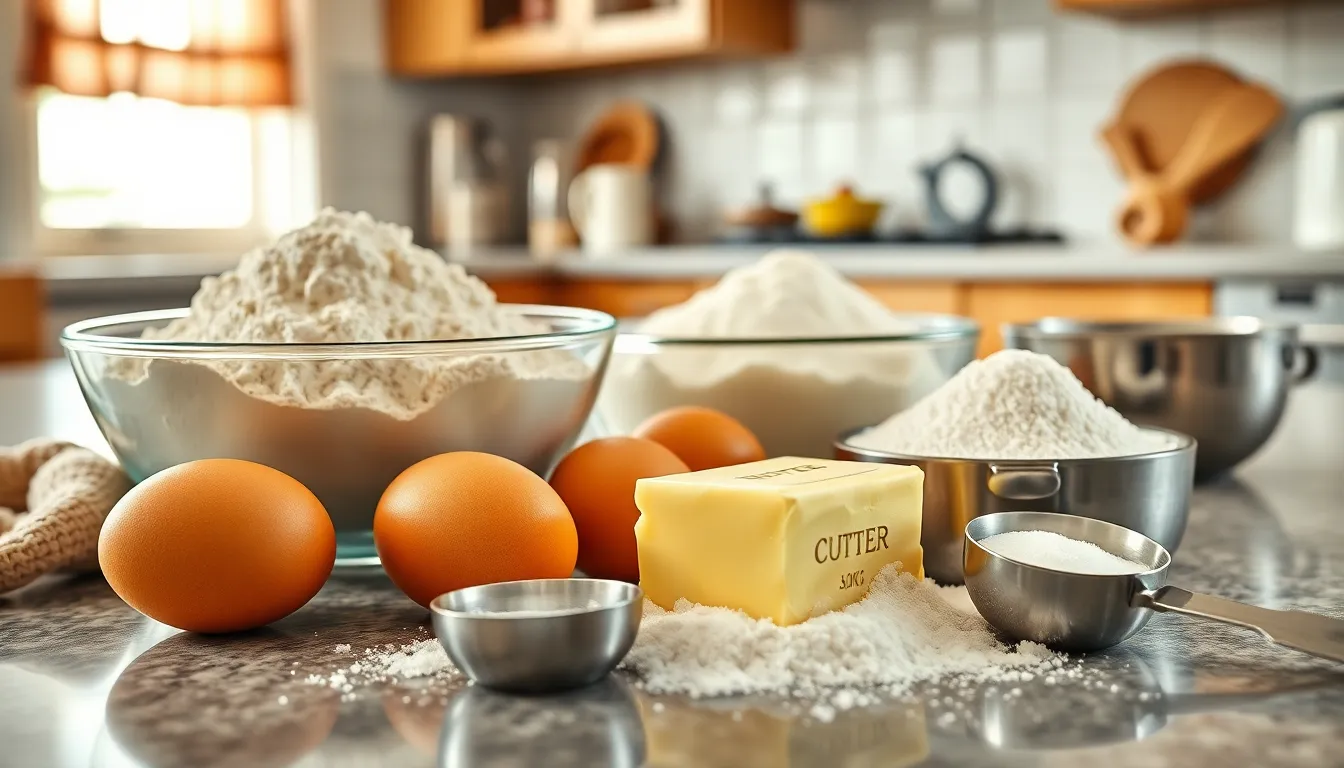
Understanding how individual ingredients impact cake structure helps us prevent the disappointment of sunken cakes. Each component plays a exact role in creating the delicate balance that keeps our cakes perfectly risen.
Flour Type and Measurement
Flour forms the backbone of our cake’s structure, and choosing the right type makes a important difference. Cake flour contains less protein than all-purpose flour, creating a more tender crumb that can sometimes lead to structural weakness if not balanced properly with other ingredients.
Measurement accuracy becomes critical when working with flour. Too much flour disrupts the delicate ingredient balance, potentially causing our cake to become dense and sink during or after baking. We recommend using the spoon-and-level method rather than scooping directly from the bag, which can pack up to 30% more flour into our measuring cup than intended.
Egg Temperature and Size
Room temperature eggs blend more effectively into our batter, creating a smoother mixture that bakes evenly. Cold eggs cause butter to firm up during mixing, leading to uneven distribution throughout the batter and creating a heavier texture that struggles to maintain its rise.
Egg size significantly impacts our cake’s moisture content and structure. Large eggs can make our cake overly moist and dense, while using too few eggs results in a compact structure that lacks the binding power needed to stay risen. Standard recipes typically call for large eggs, so substituting different sizes without adjusting other ingredients can throw off our cake’s structural integrity.
Fat Content and Temperature
Fat content directly influences our cake’s texture and stability. Insufficient fat creates a dense cake that lacks the moisture needed for proper structure, while excessive fat can make our cake too heavy to maintain its rise during baking.
Butter temperature plays a crucial role in achieving the right consistency. Properly softened butter creams effectively with sugar, creating air pockets that help our cake rise. But, if our butter becomes too warm during mixing, it can separate in the oven heat, causing the cake structure to collapse and sink.
Sugar’s Role in Structure
Sugar does more than sweeten our cakes; it actively contributes to structural stability. During the creaming process, sugar helps create air bubbles that provide lift and volume to our finished cake. These air pockets become part of the cake’s framework, supporting it as it bakes.
Insufficient sugar weakens our cake’s ability to maintain its structure during baking. Sugar also helps tenderize the crumb by interfering with gluten development, but too little sugar fails to provide the structural support our cake needs to stay risen. The balance between sweetness and structural integrity requires precise measurement to achieve optimal results.
Essential Equipment for Consistent Results

Having the right tools makes all the difference between sunken disappointments and perfectly risen cakes. We’ve identified three critical pieces of equipment that every serious baker needs for consistent success.
Oven Thermometer
Most home ovens run 25-50 degrees off their displayed temperature, making this tool absolutely essential for preventing collapsed cakes. We recommend placing an oven thermometer on the center rack to verify your actual oven temperature before each baking session. Temperature fluctuations cause cakes to rise too quickly when too hot or fail to set properly when too cool, both leading to that dreaded sunken center.
Digital probe thermometers offer the most accuracy and allow us to monitor temperature changes without opening the oven door. We position ours where we can easily read it through the oven window. This single investment eliminates the guesswork and ensures our cakes bake at the precise temperature needed for proper structure development.
Kitchen Scale
Accurate ingredient measurement prevents the structural imbalances that cause cakes to sink during baking. We strongly advocate for weighing ingredients rather than using volume measurements, as flour can vary by up to 30% depending on how it’s scooped and packed. A quality digital kitchen scale eliminates these variables and delivers consistent results every time.
Professional bakers rely on scales because they provide precision that measuring cups simply cannot match. We weigh our flour, sugar, butter, and even eggs to ensure exact ratios that support proper cake structure. This method removes the common measurement errors that lead to too much liquid or insufficient binding agents in our batter.
Proper Measuring Tools
When volume measuring becomes necessary, using the correct tools ensures accuracy in our ingredient ratios. We keep separate sets of measuring cups for dry and wet ingredients, as using the wrong type can introduce measurement errors that destabilize cake structure. Dry measuring cups should be filled and leveled, while liquid measuring cups need clear markings at eye level for precision.
Quality measuring spoons matter just as much for smaller quantities of critical ingredients like baking powder and vanilla extract. We invest in stainless steel measuring tools that won’t warp or wear down over time. These tools help us maintain the precise ingredient balance needed to prevent the overmixing and undermixing issues that contribute to sunken cakes.
Step-by-Step Prevention Method
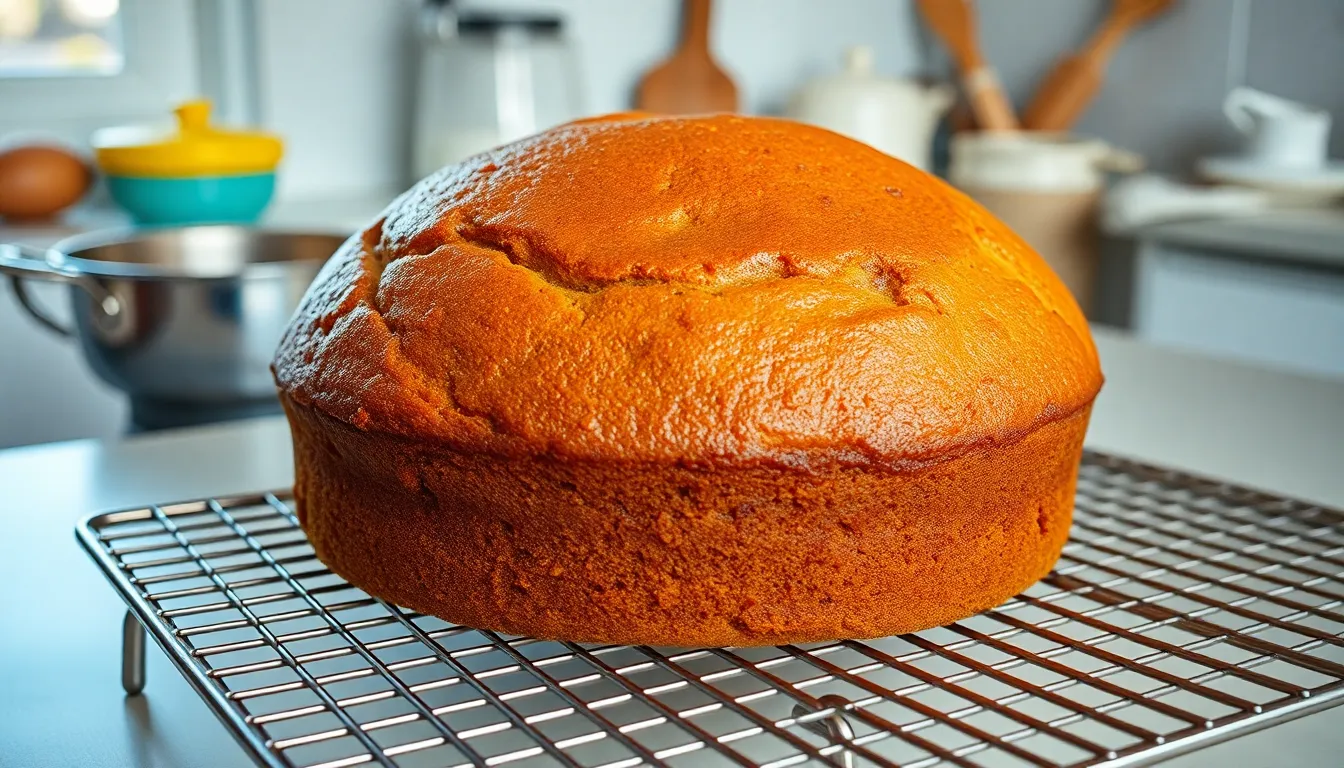
We’ve identified the key causes of sunken cakes, and now we’ll walk through our proven prevention method. Following these systematic steps ensures your cake maintains its structure from mixing bowl to cooling rack.
Prep Work
Check your leavening agents first. Expired baking powder and baking soda lose their potency and cannot provide adequate lift, causing cakes to sink during baking. We recommend replacing these ingredients every 12 months to maintain optimal performance.
Measure ingredients with precision. Too much leavening agent creates rapid rising followed by dramatic collapse. Use level measurements and avoid adding extra “for good measure” as this disrupts the delicate chemical balance.
Select the appropriate pan size for your recipe. Pans that are too small force batter to rise too high initially, creating an unstable structure that inevitably sinks. Match your pan dimensions exactly to recipe specifications.
Verify ingredient freshness across the board. Fresh ingredients provide optimal leavening power and structural support, while stale components compromise cake integrity from the start.
Mixing Technique
Mix wet and dry ingredients separately before combining. This approach prevents overdevelopment of gluten strands that create tough, dense textures. Fold ingredients together gently using a wooden spoon or rubber spatula.
Avoid overmixing the final batter. Excessive mixing incorporates too many air bubbles, creating a weak structure that collapses under its own weight. Stop mixing as soon as ingredients are just combined.
Control the creaming process carefully. Cream butter and sugar only until just combined rather than until fluffy. Over creaming introduces excessive air that leads to structural instability during baking.
Maintain proper ingredient temperatures. Room temperature ingredients blend more easily and require less mixing time, reducing the risk of overworking the batter.
Baking Process
Use an oven thermometer to verify actual temperature. Home ovens frequently run 25 to 50 degrees off their displayed settings. Accurate temperature control prevents the rapid rising and subsequent sinking caused by temperature fluctuations.
Avoid opening the oven door prematurely. Temperature drops from door openings cause partially set cakes to collapse. Wait until at least 75% of baking time has elapsed before checking progress.
Test for doneness with a toothpick. Insert the tester into the center of the cake. When it emerges clean or with just a few moist crumbs, your cake has developed sufficient structure to support itself.
Recognize signs of underbaking early. Jiggly centers and pale surfaces indicate insufficient baking time. Underbaked cakes lack the protein structure needed to maintain their shape.
Cooling Instructions
Allow complete cooling in the pan initially. Removing hot cakes from pans causes structural collapse as the proteins haven’t fully set. Let cakes rest in their pans for 10 to 15 minutes.
Transfer to wire racks gradually. This cooling method prevents rapid temperature changes that can cause sinking. The gradual cooling process allows the cake structure to stabilize properly.
Resist the urge to speed cooling. Placing hot cakes in refrigerators or freezers creates temperature shock that leads to collapse. Room temperature cooling ensures even structural development throughout the cake.
How to Fix a Sunken Cake
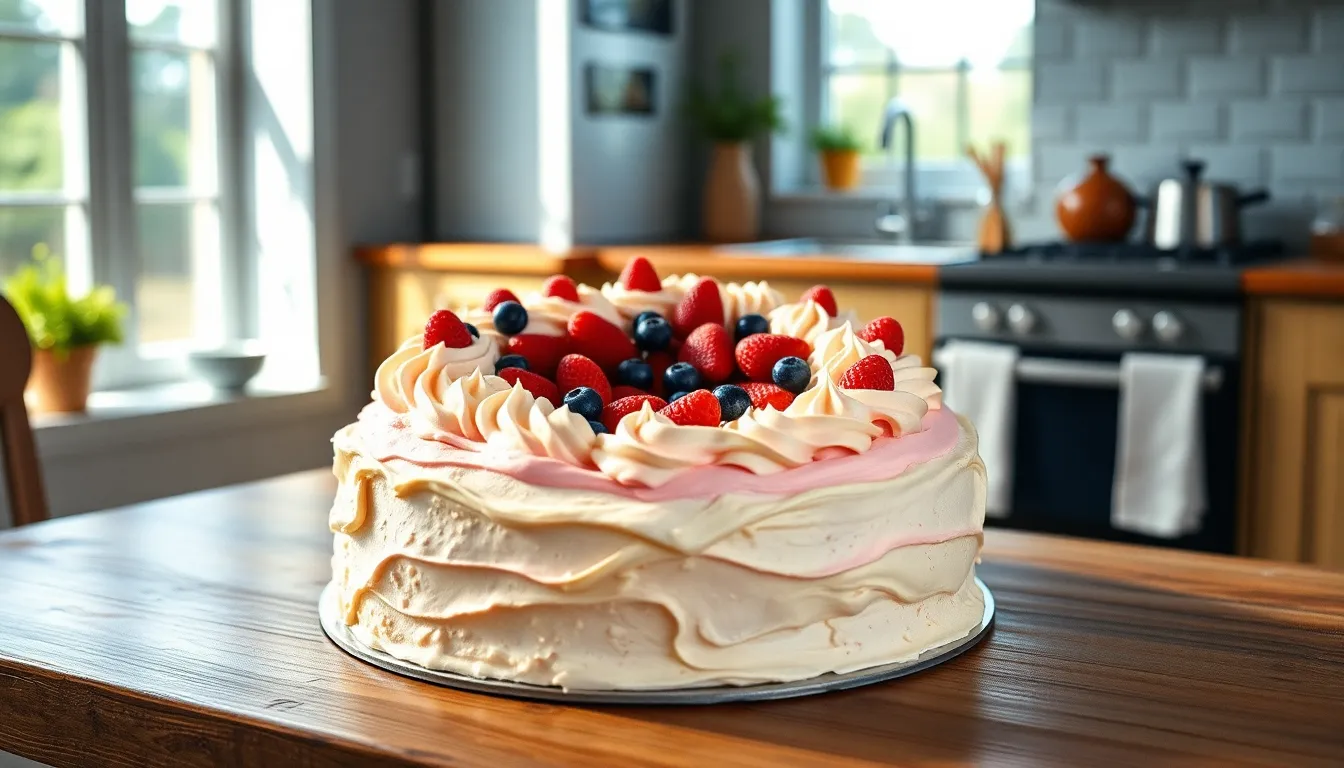
While prevention is always our first line of defense against sunken cakes, we can still rescue these baking mishaps with the right techniques. Our proven methods will help transform your collapsed cake into something delicious and presentable.
Salvage Methods
Level the Cake works as our most straightforward approach to dealing with a sunken center. We carefully trim off the sunken top portion using a sharp serrated knife to create a completely flat surface. This method allows us to use the remaining cake as a solid base for layering or frosting applications.
Fill the Dip offers another practical solution when we want to maintain the cake’s original height. We fill the sunken area with various options including buttercream frosting, fresh fruit, whipped cream, or even a complementary cake filling. This technique effectively disguises the collapse while adding extra flavor and visual appeal to our final presentation.
Both methods require us to work with a completely cooled cake to prevent further structural damage during the repair process.
Creative Answers
Turn It Upside Down transforms our baking mistake into an intentional design choice. We flip the cake so the sunken side becomes the base, creating a stable foundation for layered cake constructions. This approach works particularly well when we plan to add multiple cake layers or extensive frosting decoration.
Make a Trifle or Parfait gives us an elegant dessert option from our collapsed cake. We crumble the cake into bite-sized pieces and layer them with custard, whipped cream, fresh berries, or chocolate sauce in clear glasses. This presentation method completely eliminates any evidence of the original sinking problem while creating an impressive layered dessert.
Cake Pops provide our most creative transformation solution. We crumble the entire cake into fine pieces, mix it with frosting to create a moldable consistency, and form the mixture into balls. After chilling, we dip each ball in melted chocolate or candy coating and attach lollipop sticks. This method turns our baking failure into a completely different treat that guests will never suspect started as a sunken cake.
Each creative solution requires us to let the cake cool completely before beginning the transformation process to ensure the best possible results.
Make-Ahead Tips for Success
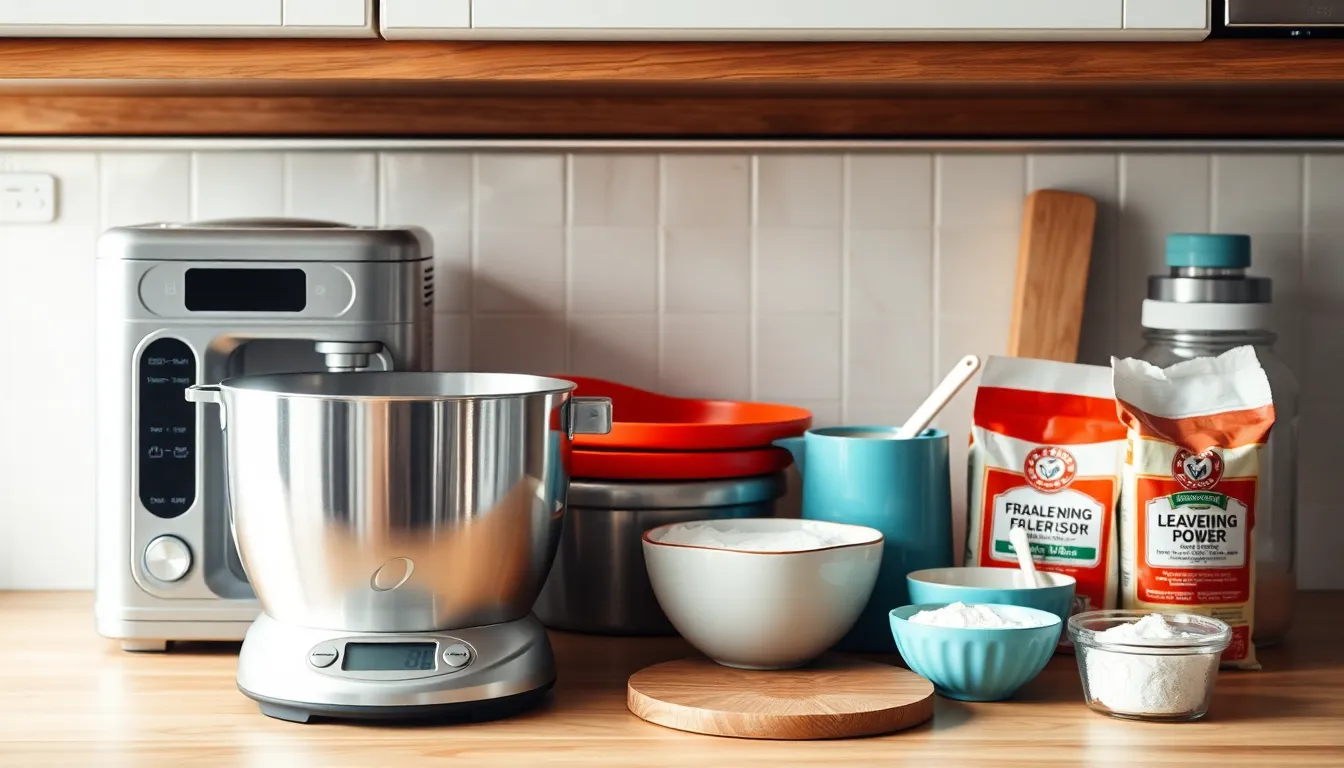
Preparing for success starts long before we mix our first ingredient. We can take several proactive steps to ensure our cakes rise beautifully and maintain their structure throughout the baking process.
Check Your Leavening Agents First
Fresh leavening agents form the foundation of a properly risen cake. We should test our baking powder by adding a teaspoon to hot water – it should bubble vigorously if it’s still active. Baking soda requires a different test: mix it with a small amount of vinegar to check for immediate fizzing. Replace any leavening agents that fail these tests, as expired products cannot provide the lift our cakes need.
Measure Accurately Every Time
Precise measurements prevent the ingredient imbalances that lead to structural collapse. We recommend using a digital kitchen scale for the most accurate results, especially when measuring flour. When using measuring cups, we should spoon flour into the cup and level it with a knife rather than scooping directly from the bag, which can pack the flour and throw off our ratios.
Verify Your Oven Temperature
An oven thermometer becomes our most reliable ally in preventing temperature-related sinking. We should place it in the center of our oven and allow at least 15 minutes for the temperature to stabilize before baking. Most home ovens vary by 25 to 50 degrees from their displayed temperature, making this verification step essential.
Choose the Right Pan Size
Using appropriately sized pans ensures even baking and proper structure development. We should fill our pans no more than two-thirds full to allow room for rising. When batter overflows or gets distributed unevenly, it creates weak spots that contribute to sinking in the center.
Plan Your Mixing Strategy
Organizing our ingredients at room temperature before we begin mixing saves time and improves our results. We should take eggs and butter out of the refrigerator 30 to 60 minutes before baking. Room temperature ingredients blend more easily and create a more stable emulsion, which translates to better cake structure.
Avoid Opening the Oven Door Early
Patience during baking prevents the sudden temperature drops that cause cakes to collapse. We should resist the urge to check our cake until at least 75% of the recommended baking time has passed. Opening the door too early allows heat to escape and disrupts the delicate setting process happening inside our cake.
Troubleshooting Guide for Future Bakes

We’ve compiled a comprehensive troubleshooting guide based on the most common cake sinking issues to help you avoid future baking disasters. Each solution addresses exact problems that experienced bakers encounter regularly.
Ingredient Measurement Accuracy
Incorrect ingredient ratios remain the leading cause of structural collapse in home baking. We recommend investing in a digital kitchen scale to ensure precise measurements according to your recipe. Measuring cups can vary by up to 20% in accuracy compared to weight measurements.
Proper Cake Pan Selection
Using a cake tin that’s too small forces your batter to rise beyond its structural capacity. We suggest choosing a pan that allows your batter to fill only two-thirds of the total volume. This gives your cake adequate room to rise without overwhelming the delicate protein structure.
Mixing Technique Mastery
Undermixing creates uneven batter distribution while overmixing develops excessive gluten and incorporates too many air bubbles. We advise mixing ingredients just until combined and avoiding over-creaming butter and sugar beyond the recommended time in your recipe.
Oven Temperature Verification
Most home ovens run 25-50 degrees off their displayed temperature. We strongly recommend using an oven thermometer to verify actual internal temperature before baking. This simple tool prevents the temperature fluctuations that cause rapid rising followed by dramatic collapse.
Leavening Agent Management
Expired baking powder and baking soda lose their lifting power over time while excessive amounts create unstable rise patterns. We suggest checking expiration dates monthly and measuring leavening agents with precision measuring spoons rather than regular flatware.
Baking Time Completion
Removing cakes from the oven before they’re fully set prevents proper protein coagulation. We recommend testing doneness with a toothpick or cake tester inserted into the center. The tester should come out with just a few moist crumbs attached.
Strategic Oven Door Management
Opening the oven door during the first 75% of baking time introduces cold air that disrupts the rising process. We advise resisting the urge to check your cake until the minimum baking time has nearly elapsed. Use your oven light for visual monitoring instead.
| Common Mistake | Impact Level | Solution Priority |
|---|---|---|
| Incorrect measurements | High | Use digital scale |
| Wrong pan size | Medium | Check capacity ratio |
| Temperature issues | High | Verify with thermometer |
| Expired leavening | Medium | Monthly freshness check |
| Early door opening | High | Wait until 75% done |
| Underbaking | High | Test with toothpick |
Conclusion
Achieving perfectly risen cakes doesn’t have to remain a mystery. We’ve equipped you with the essential knowledge to identify what causes cakes to sink and how to prevent these baking disasters from happening again.
Remember that successful baking is all about precision and patience. Every ingredient serves a exact purpose and proper technique makes the difference between success and disappointment.
The next time you’re in the kitchen we’re confident you’ll create beautifully risen cakes that stay that way. With these proven strategies and troubleshooting tips you’ll transform from frustrated baker to confident cake creator.
Your perfectly structured cakes await – it’s time to put this knowledge into practice and enjoy the results you’ve always wanted.
Frequently Asked Questions
Why do cakes sink in the middle after baking?
Cakes typically sink due to incorrect oven temperatures, measurement errors, overmixing the batter, or opening the oven door too early. These factors disrupt the cake’s structure during the crucial setting process. Using expired or incorrect amounts of leavening agents can also cause collapse, as can underbaking or environmental factors like high altitude and humidity.
How can I tell if my oven temperature is accurate?
Use an oven thermometer to verify your oven’s actual temperature, as many home ovens have temperature discrepancies of 25-50 degrees. Place the thermometer in the center of your oven and preheat for at least 20 minutes. If there’s a significant difference, adjust your baking temperature accordingly or have your oven calibrated.
What’s the best way to measure ingredients for cakes?
Use a digital kitchen scale for the most accurate measurements, especially for flour and sugar. When using measuring cups, spoon flour into the cup and level it off rather than scooping directly. Measure liquids at eye level in clear measuring cups, and ensure all ingredients are at room temperature unless specified otherwise.
When is it safe to open the oven door while baking?
Wait until at least 75% of the baking time has passed before opening the oven door. Opening too early causes temperature fluctuations that can make the cake’s structure collapse. Instead, use the oven light to check progress, and only open the door when you’re ready to test for doneness with a toothpick.
How do I know if my leavening agents are still fresh?
Test baking powder by mixing 1 teaspoon with 1/3 cup hot water – it should bubble vigorously if fresh. For baking soda, mix 1/4 teaspoon with 2 teaspoons white vinegar – it should fizz immediately. Replace leavening agents every 6-12 months and always check expiration dates before baking.
Can I fix a sunken cake after it’s baked?
Yes, there are several ways to salvage a sunken cake. You can level the cake and fill the dip with frosting or fruit, flip it upside down for a stable base, transform it into a trifle or parfait, or make cake pops. Always let the cake cool completely before attempting any repairs.
What equipment do I need to prevent cake sinking?
Three essential tools can help prevent sunken cakes: an oven thermometer for accurate temperature monitoring, a digital kitchen scale for precise ingredient measurements, and proper measuring cups and spoons. These tools help maintain the correct ingredient ratios and baking conditions necessary for proper cake structure.
How does overmixing affect cake structure?
Overmixing develops too much gluten in the flour, creating a tough, dense texture that’s more likely to collapse. It can also deflate air bubbles created during the creaming process. Mix ingredients just until combined, and use gentle folding motions when incorporating dry ingredients into wet mixtures.
Why does altitude affect cake baking?
At high altitudes, lower air pressure causes cakes to rise faster and higher, making them more likely to collapse. Reduce leavening agents by 1/8 teaspoon per teaspoon, increase liquid slightly, and raise oven temperature by 15-25°F. These adjustments help create a more stable cake structure at elevation.
How long should I cool my cake before removing it from the pan?
Allow cakes to cool in the pan for 10-15 minutes before turning them out onto wire racks. This gives the structure time to set without becoming too cool and sticking to the pan. Avoid rapid cooling methods like refrigeration, which can cause the cake to contract and crack.

